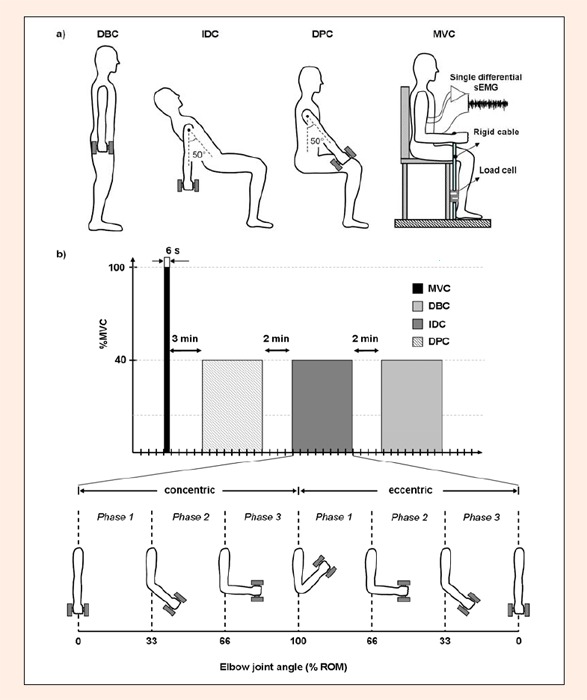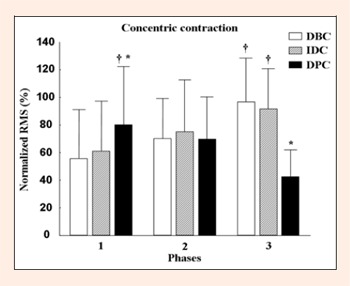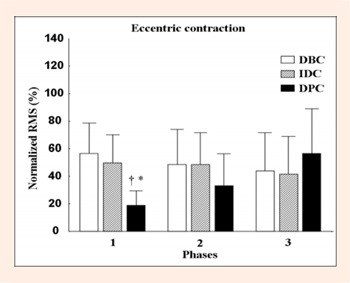Abstract
Incline Dumbbell Curl (IDC) and Dumbbell Preacher Curl (DPC) are two variations of the standard Dumbbell Biceps Curl (DBC), generally applied to optimize biceps brachii contribution for elbow flexion by fixing shoulder at a specific angle. The aim of this study is to identify changes in the neuromuscular activity of biceps brachii long head for IDC, DPC and DBC exercises, by taking into account the changes in load moment arm and muscle length elicited by each dumbbell curl protocol. A single cycle (concentric-eccentric) of DBC, IDC and DPC, was applied to 22 subjects using a submaximal load of 40% estimated from an isometric MVC test. The neuromuscular activity of biceps brachii long head was compared by further partitioning each contraction into three phases, according to individual elbow joint range of motion. Although all protocols elicited a considerable level of activation of the biceps brachii muscle (at least 50% of maximum RMS), the contribution of this muscle for elbow flexion/extension varied among exercises. The submaximal elbow flexion (concentric) elicited neuro muscular activity up to 95% of the maximum RMS value during the final phase of IDC and DBC and 80% for DPC at the beginning of the movement. All exercises showed significant less muscle activity for the elbow extension (eccentric). The Incline Dumbbell Curl and the classical Dumbbell Biceps Curl resulted in similar patterns of biceps brachii activation for the whole range of motion, whereas Dumbbell Preacher Curl elicited high muscle activation only for a short range of elbow joint angle.
Key points.
The Incline Dumbbell Curl and the Dumbbell Biceps Curl resulted in a considerable neuromuscular effort throughout the whole elbow range of motion.
The Incline Dumbbell Curl and the Dumbbell Biceps Curl may be preferable for the improvement of biceps brachii force in training programs.
Key words: Biceps curl, EMG, biceps brachii.
Introduction
Resistance training exercises are mostly applied to overload the musculoskeletal system, leading to the accelerated enhancement of muscle strength (Fleck and Kraemer, 1997). Equipments like dumbbells, barbells and cable machines are often used in conditioning and strengthening programs (Biscarini et al., 2005). However, the use of free loads may be preferred in some occasions, since it does not constrain the movement and different exercises can be performed, eliciting the contribution of specific muscles (Cotterman et al., 2005). Furthermore, free load-based exercises mimics body movements in natural situations and elicits joint and segments stabilization (Cotterman et al., 2005). Many people are addicted to the benefits provided by training programs based on the use of free loads, from experienced athletes to children and elderly (Faigenbaum et al., 2003; Falk and Tenenbaum, 1996; Fleck and Kraemer, 1997).
The weight of dumbbells or barbells is constantly oriented in a vertical direction, so that the load torque changes with joint angle and the peak of the load torque changes for different body positions (i.e. horizontal or inclined benches). According to a biomechanical model for simulating Dumbbell Biceps Curl (DBC) exercise (Biscarini et al., 2005), the force produced by elbow flexors in quasi-static exercises increases with the load moment arm, which highly affects the direction and magnitude of joint internal forces. Moreover, the classic length-tension relationship is critical for muscle force production, especially during low velocity/high intensity exercises (Lieber, 2002). Although such relationship holds for isometric contractions, it can still be used to predict muscle force from joint angle during low velocity contractions.
Incline Dumbbell Curl (IDC) and Dumbbell Preacher Curl (DPC) are two variations of the standard DBC, generally applied to optimize biceps brachii contribution for elbow flexion by fixing shoulder angle at a specific value. These different protocols for dumbbell curl may impose different demands to the neuromuscular system, resulting in different solutions for the load sharing between elbow flexors.
The aim of this study is to identify changes in the neuromuscular activity of biceps brachii long head for IDC, DPC and DBC exercises, by taking into account the changes in load moment arm and muscle length elicited by each dumbbell curl protocol. In the IDC protocol the biceps brachii long head is initially lengthened, whereas in DPC the shoulder is flexed and, thus, the biceps long head is initially shortened. Therefore, we expect to observe greater neuromuscular activity for the beginning of IDC and DPC exercises than for DBC, mainly due to different postural demands.
Methods
Subject
A group of 22 male subjects (23.0 ± 3.5 years, 79.6 ± 11.6 kg and 1.8 ± 0.1 m) participated of the study after providing written consent. All participants were right handed, did not relate any history of osteomyoarticular injuries and were engaged in strength programs for at least one year. This experiment was approved by the University Ethical Committee.
Experimental setup
A single cycle (concentric- eccentric) of DBC and its variations, IDC and DPC, was applied to each subject using a submaximal load of 40%, estimated from a single 6s isometric MVC test (Kamen, 2004). Although in practical situations most lifters may choose a different load for each exercise, the use of a fixed load was compulsory to compare the neuromuscular demand elicited between DPC, IDC and DBC protocols. The 40% MVC load was chosen on empirical basis, since with this load all subjects could perform one or two cycles of dumbbell curl with slow speed. Dumbbell curls were randomly applied with two minutes (2 min) interval, after the three minutes (3 min) rest period following the MVC trial. A complete schematic of trials sequence is shown in Figure 1b, whereas body orientation for each trial is outlined in Figure 1a and is defined as: MVC - seated position with right elbow at 90° and forearm supinated; IDC - seated with trunk in vertical position and right shoulder flexed at 50°; IDC - seated with 50° of trunk hyperextension and the right arm hanging freely; DBC - standing with a comfortable support base and the arms alongside the body.
Figure 1.

Schematics of the experimental setup. a) Body orientation for each dumbbell curl protocol and for the MVC trial including electrodes placement; b) Time sequence of each test trial (randomized) and rest periods; c) Partition of the dumbbell curls cycle into concentric and eccentric contractions and further division into three phases according to elbow joint angle.
The display of force output was provided during MVC trials and all subjects were allowed to track it before starting the test. Each subject performed the whole cycle of dumbbell curls at his preferred speed, thus reproducing the movement observed in practical situations. Although the use of a metronome is important for controlling movement speed, it likely provides biased comparisons between subjects, since individual strategies may emerge to compensate the fixed pace imposed by an external stimulus.
Single differential surface EMG (gain = 1k, CMRR = 106 dB, and bandwidth of 10-500 Hz) and elbow joint angle were synchronously sampled at 1 kHz by a 16 bits A/D converter (± 10V dynamic range). Elbow joint angle was estimated from changes in the direction of the uniaxial accelerometer (0-200 Hz bandwidth and 315 mVg-1 sensitivity) with respect to gravity acceleration vector, assuming that all subjects flexed and extended the elbow with constant velocity. The accelerometer was fixed to the subject’s wrist with a tape and with its normal axis orientated vertically. Two circular (20 mm diameter, 20 mm interelectrodes distance) Ag-AgCl pre-gelled electrodes were positioned on biceps brachii long head according to SENIAM recommendations, after skin preparation (Freriks et al., 1999). A load cell (200 Kgf fullscale) was used to measure the peak force during the MVC trial.
Data analysis
The neuromuscular activity of biceps brachii long head was compared by dividing a curl cycle into concentric and eccentric contractions, and by further partitioning each contraction into three phases, according to individual elbow joint range of motion (Figure 1c; i.e. phase 1 = 0 - 33%; phase 2 = 34 - 67% and phase 3 = 68 - 100% of ROM). The sEMG root mean square (RMS) was estimated for each phase and contraction according to the following equation:
where x[n] is the raw sEMG, c and p stands for contraction type (concentric or eccentric) and contraction phase (1, 2 or 3), respectively, and n is the sample number ranging from phase start (ps) to phase end (pe), for each one within each contraction type. To avoid the effect of geometrical and physiological factor on sEMG data, the RMS amplitude was normalized for the maximum RMS value estimated from the MVC trial, by using equation 1 with n ranging from 1000 (1s) to 5000 (5s).

Statistical analysis
A multifactorial ANOVA design 3x2x3 (exercises x contraction types x contraction phases) was applied to compare changes in RMS amplitude according to different contraction types and phases, within and between the dumbbell curl protocols. Significant changes in the size or duration of the elbow flexion/extension cycles between exercises were assessed by applying the one-way ANOVA design. The Tukey Post Hoc test was applied to identify significant difference between means with p value set to 0.05 (Statistica 6.0 - StatSoft, Inc.).
Results
The maximal force achieved during the MVC trial was 34.4 ± 5.0 Kg. The load corresponding to 40% of the MVC score, which was applied in this study for the dumbbell curl exercises, represented about 43.6 % of individual body mass.
When comparing RMS values for the concentric contractions between IDC and DBC exercises, no statistical differences were observed, even when considering each phase independently (Figure 2). On the other hand, the sEMG amplitude increased for both IDC and DBC protocols from the beginning to the end of concentric contraction, reaching statistical significance (p <0.05) at phase 3. Interestingly, for DPC protocol the RMS mean values showed an opposite trend throughout the three phases, decreasing from phase 1 to phase 3 (p < 0.05). In addition, statistical difference was observed between DPC and the other two exercises. RMS amplitude was higher and lower for DPC at phase 1 and 3, respectively, when compared to RMS values for IDC and DBC, suggesting that shoulder flexion angle affects biceps brachii activation.
Figure 2.

Mean and SD of RMS values for all phases of concentric contractions, divided according to each exercise (DBC, IDC and DPC). * p < 0.05 between exercises, † p < 0.05 between phases.
Figure 3 shows the RMS values for all phases of the eccentric contraction. Even for the eccentric contraction, IDC and DBC presented no differences for the muscle activation between the three phases. The RMS value for the initial phase of DPC was significantly lower when compared to that measured for DBC and IDC.
Figure 3.

Mean and SD (whiskers) of RMS values for all phases of eccentric contractions, divided according to each exercise (DBC, IDC and DPC). * p < 0.05 between exercises, † p < 0.05 between phases.
Table 1 shows the amplitude and time duration (mean values and standard deviation) of both concentric and eccentric contractions. A significant increase of curl duration was observed for the eccentric contraction, independent of the exercise. IDC protocol was performed within a statistical smaller ROM of the elbow joint, with respect to the other two dumbbell curl exercises.
Table 1.
Mean (SD) of duration and range of motion (ROM) of the concentric end eccentric phases of each exercise.
| Exercise | Duration (sec) | ROM (degrees) | |
|---|---|---|---|
| Concentric | Eccentric | ||
| DBC | 3.59 (.91) * | 4.05 (.93) | 131.9 (18.3) |
| IDC | 3.81 (1.13)* | 4.67 (1.57) | 134.3 (19.5) |
| DPC | 4.47 (1.60)† | 4.65 (1.68) | 115.5 (11.2) * |
* p < 0.05 between phases, † p < 0.05 between exercises
Discussion
By dividing elbow flexion and extension in three different phases, according to joint ROM, we expected to observe changes in modulation of neuromuscular activity for the three dumbbell curl protocols. Dumbbell Biceps Curl and Inclined Dumbbell Curl elicited similar pattern of increasing and decreasing muscle activation along the three phases, for the concentric and eccentric contractions respectively, whereas an opposite trend of sEMG RMS amplitude was observed for the Dumbbell Preacher Curl.
Concerning the choice of an appropriate load representing 40% of individual maximum, the mean MVC score observed in this study (43.6 ± 7.7% of individual body mass) was far higher than that reported by Kasprisin and Grabiner (2000) (30.6 ± 4.7% for 10 healthy adults). This difference likely results from the elbow joint angle considered for the MVC trial, since at 90° of elbow flexion the biceps brachii fibers may be closer to optimal length for isometric force production (Hay, 1991; Inman et al., 1982; Langenderfer et al., 2005; Oliveira, 2004), with respect to the 75° elbow flexion considered by Kasprisin and Grabiner (2000).
The submaximal elbow flexion elicited neuromuscular activity up to 95% of the maximum RMS value during the phase 3 of the concentric contraction for the IDC and DBC protocols. This relatively high neuromuscular activity suggests that the 40% MVC load was sufficient to elicit high modulation of sEMG amplitude.
The mean duration and size of either concentric or eccentric contractions ranged from 3.59 ± 0.91 to 4.65 ± 1.68 s and from 115.50 ± 11.20 to 131.91 ± 18.25°, respectively, therefore characterizing a quasi-isometric movement (Siff, 2004). Since force production is critically affected by muscle tension-length relationship, only for movements performed at low velocities (Lieber, 2002), the neuromuscular activity for all protocols was expected to be highly dependent on muscle length. Furthermore, Prilutsky, 2004 observed a similar level of neuromuscular activity of biceps brachii muscle for eccentric contractions with constant speed, corroborating the almost constant RMS values (Figure 3) observed for the eccentric contractions performed in this study. This evidence supports the effect of muscle length on the muscle force production, since dumbbell curls may have been performed with minimal changes at movement velocity.
Although subjects were instructed to start from full elbow extension, their movements started from a slightly flexed position (around 20°), suggesting a compensation mechanism to optimize the contribution of elbow flexors and passive tension. Some studies reported similar strategy for starting the movement, with elbow joint angle ranging from 15° to 48° (Hansen et al., 2003; Keeler et al., 2001; Uchiyama et al., 1998).
During isometric contractions, the increase of muscle force heavily relies on both motor unit firing rate and recruitment, according to the size principle (Henneman, 1985). However, the use of these strategies seems to be reweighted in a different way during dynamic contraction, with the recruitment of additional motor units playing a critical role in muscle force production (Sbriccoli et al., 2003; Søgaard et al., 1998). Such changes in motor unit recruitment pattern, in addition to different load sharing strategies, may have contributed to the high variability of RMS values between subjects (coefficient of variation ranged from 31 to 69 %, for all phases and contractions).
Regarding the changes in sEMG amplitude for different dumbbell curl protocols, it was expected an increase of neuromuscular activity during IDC, especially when elbow joint was close to full extension. The shoulder hyperextension, elicited by the IDC protocol, stretches the long head of biceps brachii muscle beyond its optimal length, leading to an inefficient actin-myosin coupling. On the other hand, the similar RMS values between IDC and DBC (Figure 2) indicates an increased contribution of other elbow flexors, besides the contribution of passive tension from muscle and soft tissues, at the beginning of concentric and at the end of eccentric contraction. The low values of sEMG amplitude observed for the beginning of concentric contractions, independent of the dumbbell curl protocol, may be explained by the reduced load moment arm and/or the right shift of muscle length value with respect to the muscle tension-length relationship (Falk and Tenenbaum, 1996). Although at about 90o of elbow flexion the moment arm of biceps brachii is close to its highest value (Murray et al., 1995; 2002), such position was not sufficient to compensate the increment of the resistance torque, which is maximal for this joint angle, and thus resulting in high RMS values.
The shoulder flexed position in the DPC exercise elicited a particular pattern of muscle activation, which significantly decreased and increased from the initial to the final phases of the concentric and eccentric contractions, respectively. Although the early phase of the concentric contraction elicited high muscle activity to overcome the load torque, the neuromuscular demand decreased rapidly for the biceps brachii throughout the middle and late phases. The main reason for this pattern of activation is likely linked to the initial moment arm of the load, resulting from the shoulder flexion at the starting position (phase 1), and the inefficient length of elbow flexors. As the elbow flexes the load torque reduces, until the hand crosses elbow line, thus shifting the force production from elbow flexors to extensors (phase 3). Therefore, DPC exercise seems to have elicited high myoelectric activity only within a short range of elbow joint angle (i.e. the beginning of concentric and ending of eccentric contractions), which may be disadvantageous for training programs focused on the improvement biceps brachii ability to produce force.
The use of a couple of electrodes could have been a limiting factor in this study. The shift of the innervation zone (IZ), inherent to dynamic contractions, attenuates or enlarges sEMG amplitude as the IZ gets closer or farer from the electrodes (Farina et al., 2001). However, the IZ effect on the RMS values estimated in this study was minimized by positioning the electrodes on the location recommended by SENIAM, since this location is close to half way between the biceps brachii IZ and the distal tendon (Merletti and Parker, 2004).
Conclusion
Although all protocols elicited a considerable level of activation of the biceps brachii muscle (at least 50% of maximum RMS), the contribution of this muscle for elbow flexion depended of the dumbbell curl protocol. For the Dumbbell Preacher Curl cycle, the activation of biceps brachii long head was maximal, only for elbow joint angles close to full extension, and the elbow joint range of motion was shorter. The Incline Dumbbell Curl and the Dumbbell Biceps Curl resulted in a considerable neuromuscular effort throughout the whole elbow range of motion and, thus, may be preferable for the improvement of biceps brachii force in training programs.
Biographies

Liliam F. Oliveira
Employment
Biomechanics Laboratory, Bioscience Department, Physical Education and Sports School, Federal University of Rio de Janeiro, Rio de Janeiro, Brazil.
Degree
D.Sc. in Bioengineering
Research interests
Biomechanics, muscle modelling, EMG
E-mail: liliam@eefd.ufrj.br
Thiago T. Matta
Employment
Biomechanics Laboratory, Bioscience Department, Physical Education and Sports School, Federal University of Rio de Janeiro, Rio de Janeiro, Brazil.
Degree
Ms.C. student in Biomechanics
Research interests
Biomechanics.
E-mail: ttmatta@yahoo.com.br
Daniel S. Alves
Employment
Biomechanics Laboratory, Bioscience Department, Physical Education and Sports School, Federal University of Rio de Janeiro, Rio de Janeiro, Brazil.
Degree
M.Sc. student in Biomedical Engineering
Research interests
Biomechanics.
E-mail: danielves@ig.com.br

Marco A.C. Garcia
Employment
Biomechanics Laboratory, Bioscience Department, Physical Education and Sports School, Federal University of Rio de Janeiro, Rio de Janeiro, Brazil.
Degree
D.Sc. student in Biomedical Engineering
Research interests
EMG, mechanomyography, spasticity.
E-mail: marcoacg@unisys.com.br

Taian M.M. Vieira
Employment
Laboratory for Engineering of the Neuromuscular System, Polytechnic of Turin, Turin, Italy.
Degree
Ph.D. candidate in Biomedical Engineering
Research interests
Electromyography, postural balance
E-mail: taian.vierira@polito.it
References
- 1.Biscarini A., Borio R., Coscia F., Mazzolai G., Simonetti S., Rosi G. (2005) Biomechanics of dumbbell/barbell and cable biceps curl exercises. Italian Journal of Sports Science 12, 83-93 [Google Scholar]
- 2.Cotterman M.L., Darby L.A., Skelly W.A. (2005) Comparison of muscle force production using the smith machine and free weights for bench press and squat exercises. JJournal of Strength and Conditioning Research 19(1), 169-176 [DOI] [PubMed] [Google Scholar]
- 3.De Luca C.J. (1997) The use of surface electromyography in biomechanics. Journal of Applied Biomechanics 13, 135-163 [Google Scholar]
- 4.Faigenbaum A.D., Milikenm L.A., Westcott W.L. (2003) Maximal strength testing in health children. Journal of Strength and Conditioning Research 17(1), 162-166 [DOI] [PubMed] [Google Scholar]
- 5.Falk B., Tenenbaum G. (1996) The effectiveness of resistence training children. Sports Medicine 22(3), 176-186 [DOI] [PubMed] [Google Scholar]
- 6.Farina D., Merletti R., Nazzaro M., Caruso I. (2001) Effect of joint angle on EMG variables in leg and thigh muscles. IEEE Engineering in Medicine and Biology 20(6), 62-71 [DOI] [PubMed] [Google Scholar]
- 7.Fleck W.J., Kraemer S.J. (1997) Designing resistance training programs. Human Kinetics, Champaign [Google Scholar]
- 8.Freriks B., Hermens H.J., Disselhorst-Klug C., Rau G. (1999) The recommendations for signal processing methods for surface electromyography, : European recommendations for surface electromyography - SENIAM Project. : Hermens H.J., Freriks B., Merletti R., Stegeman D., Blok J., Rau G., Disselhorst-Klug C., Hâag G.Enschede: Roessingh Research and Development b.v.13-25 [Google Scholar]
- 9.Hansen E.A., Lee H., Barrett K., Herzog W. (2003) The shape of the force-elbow angle relationship for maximal voluntary contractions and sub-maximal electrically induced contractions in human elbow flexors. Journal of Biomechanics 36, 1713-1718 [DOI] [PubMed] [Google Scholar]
- 10.Hay J.G. (1991) Mechanical basis of strength expression, : Strength and power in sport. : Komi P.V.Oxford: Blackwell Science; 197-207 [Google Scholar]
- 11.Henneman E. (1985) The size-principle: a deterministic output emerges from a set of probabilistic connections. Journal of Experimental Biology 115, 105-112 [DOI] [PubMed] [Google Scholar]
- 12.Inman V.T., Ralston H.J., Todd F. (1982) Human walking. Williams & Wilkins, Baltimore [Google Scholar]
- 13.Kamen G. (2004) Reliability of motor-evoked potentials during resting and active contraction conditions. Medicine Science Sports Exercise 36(9), 1574-1579 [DOI] [PubMed] [Google Scholar]
- 14.Kasprisin J. E., Grabiner M. D. (2000) Joint angle-dependence of elbow flexor activation levels during isometric and isokinetic maximum voluntary contractions. Clinical Biomechanics 15, 743-749 [DOI] [PubMed] [Google Scholar]
- 15.Keeler L.K., Finkelstein L.H., Miller W., Fernhall B. (2001) Early-phase adaptations to traditional-speed vs. superslow resistance training on strength and aerobic capacity in sedentary individuals. Journal of Strength Conditioning Research 15, 309-314 [PubMed] [Google Scholar]
- 16.Langenderfer J., LaScalza S., Mell A., Carpenter J.E., Kuhn J.E., Hughes R.E. (2005) An EMG-driven model of the upper extremity and estimation of long head biceps force. Journal of Computers in Biology and Medicine 335, 25-39 [DOI] [PubMed] [Google Scholar]
- 17.Lieber, r.l. (2002) Skeletal muscle structure and function. Williams & Wilkins, Baltimore [Google Scholar]
- 18.Merletti R., Parker P.A. (2004) Electromyography: physiology, engineering and noninvasive applications. Wiley Interscience, Italy [Google Scholar]
- 19.Murray W.M., Buchanan T.S., Delp S.L. (2002) Scaling of peak moment arms of elbow muscles with upper extremity bone dimensions. Journal of Biomechanics 35, 19-26 [DOI] [PubMed] [Google Scholar]
- 20.Murray W.M., Delp S.L., Buchanan T.S. (1995) Variation of muscle moment arms with elbow and forearm positions. Journal of Biomechanics 28(5), 513-525 [DOI] [PubMed] [Google Scholar]
- 21.Oliveira L.F. (2004) Biomecânica, : Aspectos diversos da medicina do exercício. : Rocha M.L., Rio de Janeiro. Revinter; 224-233 [Google Scholar]
- 22.Prilutsky B.I. (2004) Ação muscular excêntrica no esporte e no exercício,: Biomecânica do esporte. Ed: Zatsiorsky V.M.Rio de Janeiro, Guanabara Koogan; 49 [Google Scholar]
- 23.Sbriccoli P., Bazzucchi I., Rosponi A., Bernardi M., De Vito G., Felici F. (2003) Amplitude and spectral characteristics of biceps Brachii sEMG depend upon speed of isometric force generation. Journal of Electromyography Kinesiology 13(2), 139-147 [DOI] [PubMed] [Google Scholar]
- 24.Siff M.C. (2004) Fundamentos biomecânicos do treinamento de força e de potência,: Biomecânica do esporte. Ed: Zatsiorsky V.M.Rio de Janeiro, Guanabara Koogan; 96 [Google Scholar]
- 25.Søgaard K., Christensen H., Fallentin N., Mizuno M., Quistorff B., Sjøgaard G. (1998) Motor unit activation patterns during concentric wrist flexion in humans with different muscle fiber composition. European Journal of Applied Physiology and Occupational Physiology 778(5), 411-416 [DOI] [PubMed] [Google Scholar]
- 26.Uchiyama T., Bessho T., Akazawa K. (1998) Static torque-angle relation of human elbow joint estimated with artificial network technique. Journal of Biomechanics 31, 545-554 [DOI] [PubMed] [Google Scholar]


